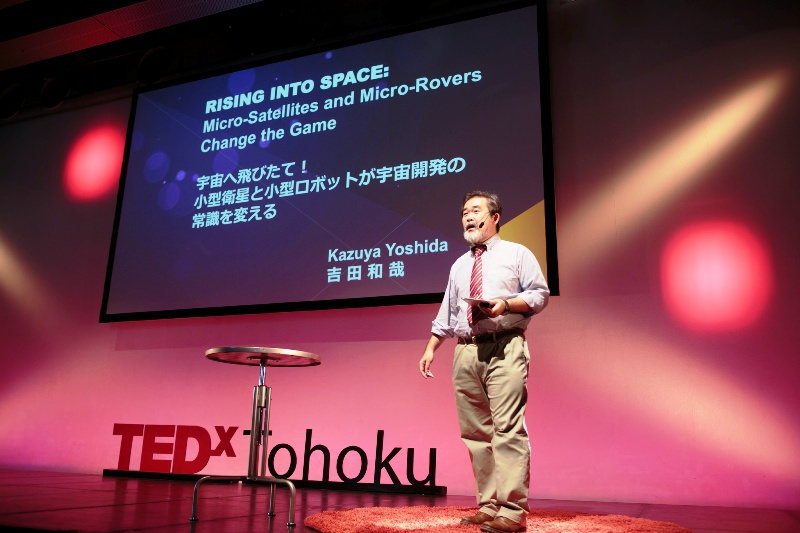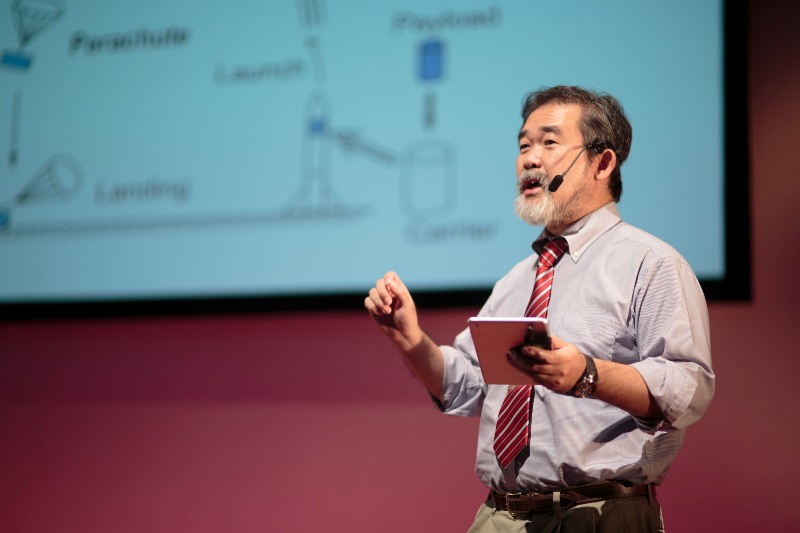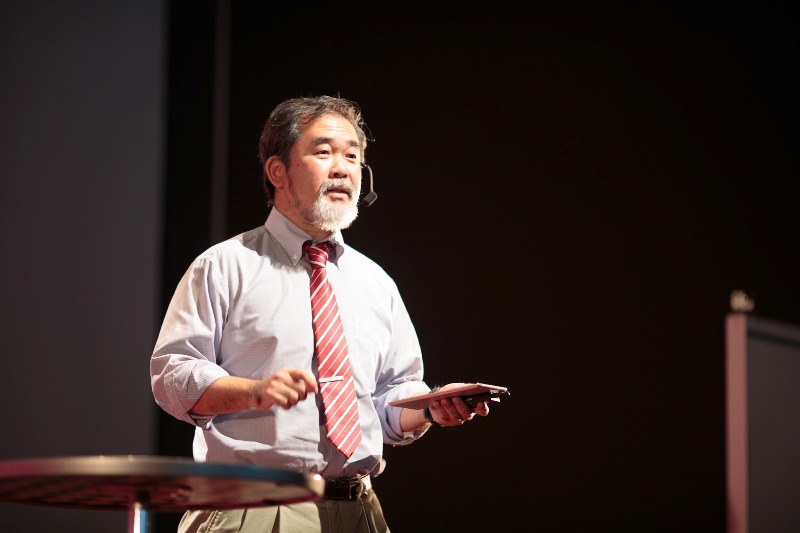|
Hi, I started up a new laboratory at Tohoku University, here in Sendai, almost 20 years ago. I was appointed as a young professor in Aerospace Engineering department. At the very beginning, in order to encourage my students, I set the goal of our research. That is to fly our dreams into space. Speaking about the "dreams," as my background is robotics, so our specific dreams are the development of robots for the exploration of unknown. To fly anything, we need a rocket. So, visited United States, and started collaboration with a group of amateur rocketry people, to fly our payloads. This US-Japan joint project was named ARLISS, which means A Rocket Launch for International Student Satellites. The launch site is Black Rock desert in Nevada state. The rocket can fly up to the sky of 4000 m altitude, not yet outer space. However, this project gives a unique opportunity for students to learn a real process of the development of a space system. Speaking about the payloads, a standard size for this project is just about 350 ml soda pop-can, therefore the project was nick-named as "CANSAT" project. These are the pictures of the launch and the descending using a parachute. The CANSAT project started in 1999. And today, the idea has spread over the world. Various colors of soda-pop cans were launched into the sky. And in the upper air, they measured the temperature and pressure, took pictures, then transmitted by radio. Students learned a number of precious lessons from this project. And the next step is the flight to real outer space. For the space flight, 10 by 10 by 10 centimeter cubic format, with just 1 kg of mass, was proposed. Today, this format is known as CUBESAT. My students in Tohoku University also developed an extensive size of cubesat, which has a camera onboard. As a very unique opportunity, it was put into orbit from the International Space Station by a Japanese astronaut! This is the Earth. Can you find tiny cubic satellites in this picture? And these are the images taken by our CubeSat RAIKO. This is the very moment that my first dream came true. A student build satellite worked out properly in the space environment. Taking pictures and transmit the data to the ground station. But our dreams are never ending. We keep developing bigger satellites, which have more capability to conduct significant science of remote sensing. Toward this new goal, my students worked so hard and did an amazing job. Now the new satellite is 50 cm in size. The weight is about 50 kgs. This format is called micro-satellite. This is our first micro-satellite, RISING. And five years later, we completed RISING-2. Now the question is how we can go to the space. The answer is a piggy back launch. The Japanese space agency, JAXA, kindly offers shared launching opportunity for microsatellites. Here, we see GOSAT, that is JAXA's huge and expensive satellite, more than 1000 kgs, several 100 M US dollars. And you can find, how small our microsatellite is. It is a small addition to them, but a great opportunity for us. The launch was beautiful for RISING-1 on January, 2009. And for RISING-2, May, 2014. Both satellites are now orbiting the Earth. And particularly, the RISING-2 is making remarkable achievements. These are the pictures of the Earth with a wide angle camera onboard. The image quality is now much improved. A huge typhoon was also captured by our onboard camera. This is a comparison between our RISING-2 imagery, on right, and the one taken by Japanese meteorological satellite, on left. Now, a student-made university satellite can compete with a professional large-scale satellite. The RISING-2 also has a color telescope camera. A close up of a landscape of a city and houses and rice fileds in Japan. This is a 5 m resolution image that is the top-of-the-world-class results in this format of microsatellite. That's amazing, and we are so happy. Now, our challenge to the micro-satellites resulted successful. Smaller, cheaper and faster development. Speaking about the cost, 100 down to 1. Yet, the imaging quality is good enough for various remote sensing missions. With one single satellite, the coverage of the Earth's surface is limited. But if you have 100 M dollar budget, I recommend you NOT to have one large and expensive satellite, but instead, you should have 48 micro-satellites. These satellites can cover the entire globe, continuously and seamlessly. In this way, you can make 24 hours monitoring of the Earth, disaster monitoring network, for example. Now, our dreams are never ending. Going back to Nevada. After a lot of success of the CANSAT projects, we came up with another new idea for a student competition, that is to build a robot, launch by a rocket, then ask them to come back home, autonomously. The robot can fly like a parafoil, or travel over the ground surface, after the landing. My students made such a two-wheel robot design. Because this shape can fit in a cylindrical body of the rocket. The mass is just about 1 kg, same as CUBESAT. Between the wheels, there is a battery, computer, sensors and motors. It has everything onboard. Every year, when new students are enrolled in my laboratory, I ask them to build a new robot rover. Then a few years later, the design became more sophisticated. This is a video clip of the student challenge in 2008. -Beautiful launch and parachute. -After the landing, the robot autonomously cut out the parachute module, because it is not useful on the ground. -Then start the surface locomotion. -The traveling velocity is really high! -Guided by the GPS coordinate, the robot travels toward the goal flag. -But, the ground surface is not always easy. So, it automatically try to get out, -And finally it got the goal flag, -And everybody was so excited. This is the result of our 7 years revolution of students' project. And today, I am happy to bring our brand-new model, with a name of Tetris, on this stage. Itfs so cute and cool. (on screen) This is our field testing video, in a Japanese sand dune, with one-step-previous-version of the Tetris. On-board camera is so exciting! Now our dream is to bring this robot onto the surface of the moon. Our driving force is the Google Lunar XPrize. This is a world-wide competition sponsored by Google for 30 M US Dollars cash prize in total. The requirements are: -You need to be a non-government entity. -Send a robot to the Moon. -Travel over the surface more than 500 meters, -Then, transmit high quality images. The rule is simple, but itfs not easy to achieve. As of today, 18 teams from a number of different countries are competing. And I am very honored to say that there is one Japanese team, which is currently in a leading group of this challenging race. That is Team Hakuto! The Hakuto means a white rabbit, (believed) living on the Moon. "ShiroUsagi" in Japanese. The team Hakuto recently announced two rover models for the proof of flight ready technologies. One is nicknamed "MoonRaker," and the other is "Tetris." Our rovers are very small, but have great potential. This one, Tetris, is just about 2 kg. Yet, advanced technologies are fully implemented in such a small body. For example, this wheel is made of super-strength plastic material by 3D printing! We operate these two rovers in such a way, connected by a tether. The XPrize rule does not specify the traveling locations. But, we have an exciting destination, that is caves. In 2007, Japanese lunar orbiter KAGUYA discovered small holes on the surface of the moon, and scientists speculate them as opening halls, or skylight, for the underground lava tubes. Natural tunnels and caves, those places are good for future human settlement, in terms of moderate temperature and natural protection from cosmic radiation and meteorite impact. The idea for the cave exploration is simple. On the edge of the hole, the bigger rover stays as an anchor, and the smaller rover, Tetris, goes down in the hole. This video clip shows this idea. This is a demonstration in a small cliff, but the same idea will work in deeper, vertical holes. After the underground exploration, the baby rover can be retrieved by winding up the tether. XPrize encourages non-government players to challenge innovative technology and new business. Space programs are not for a limited number of elite members, but should be opened to everybody to participate. Open competition will certainly change the old-fashioned space business. Still, the reality is, space programs are huge and super-expensive, slow-in-progress, a kind of off-limits and a kind of dinosaur. But micro-satellites and micro-rovers can change the games. There are a number of good ideas for small, low-cost and agile space programs. Most important thing is lower the threshold, increase the number of new players, particularly bring young people. Now, the space is very close to your reach. Hands-on satellites and hands-on rovers can make it happen. Please join us. Letfs share the excitement with everybody. Thank you. |



